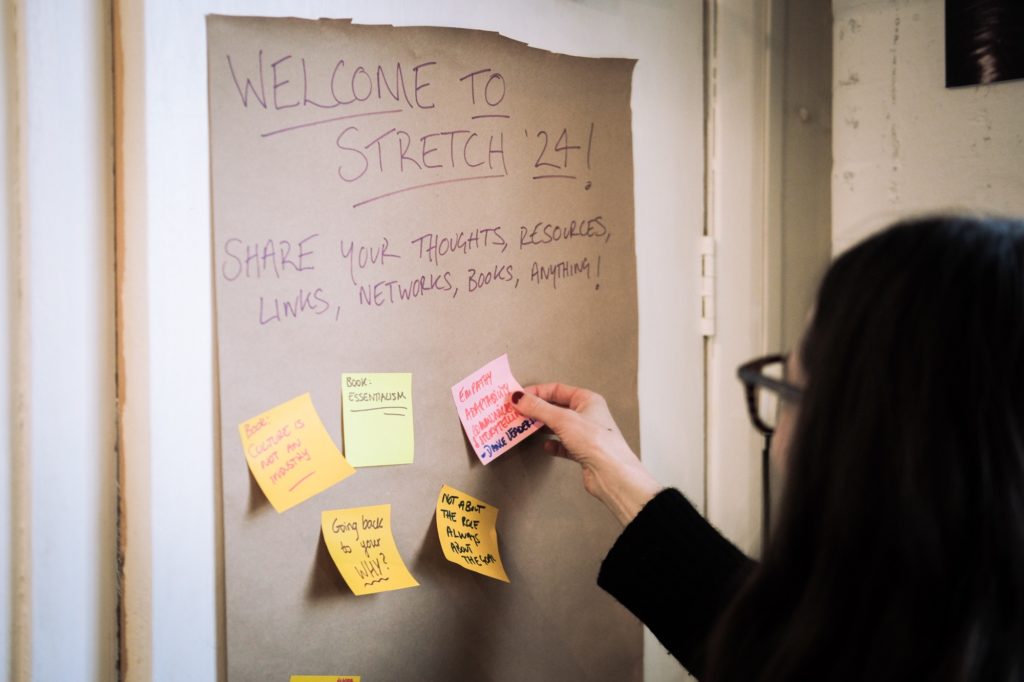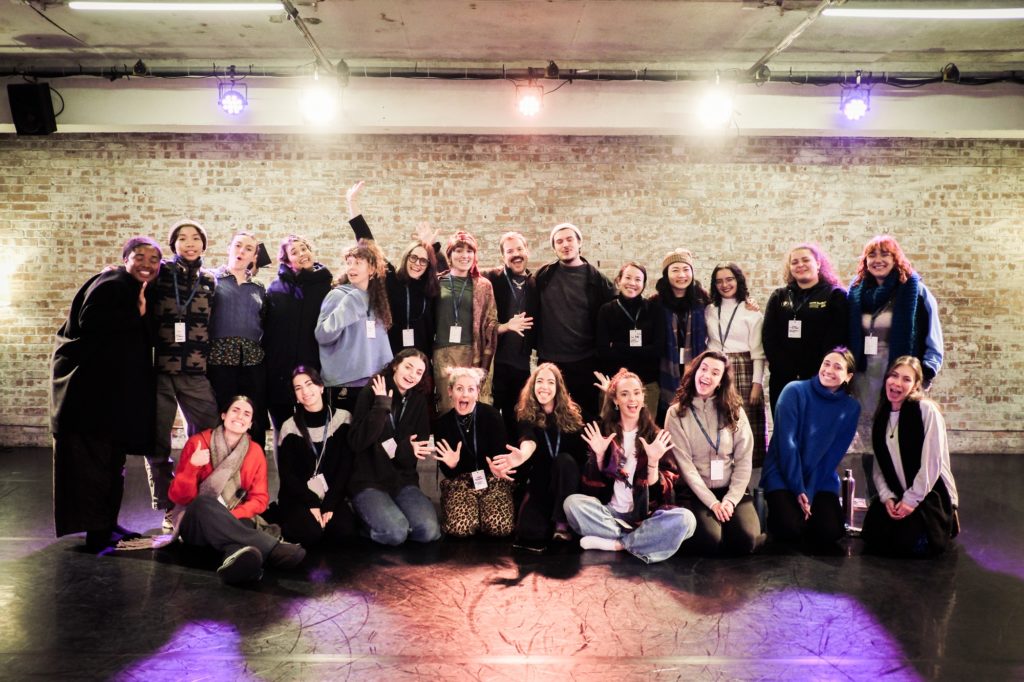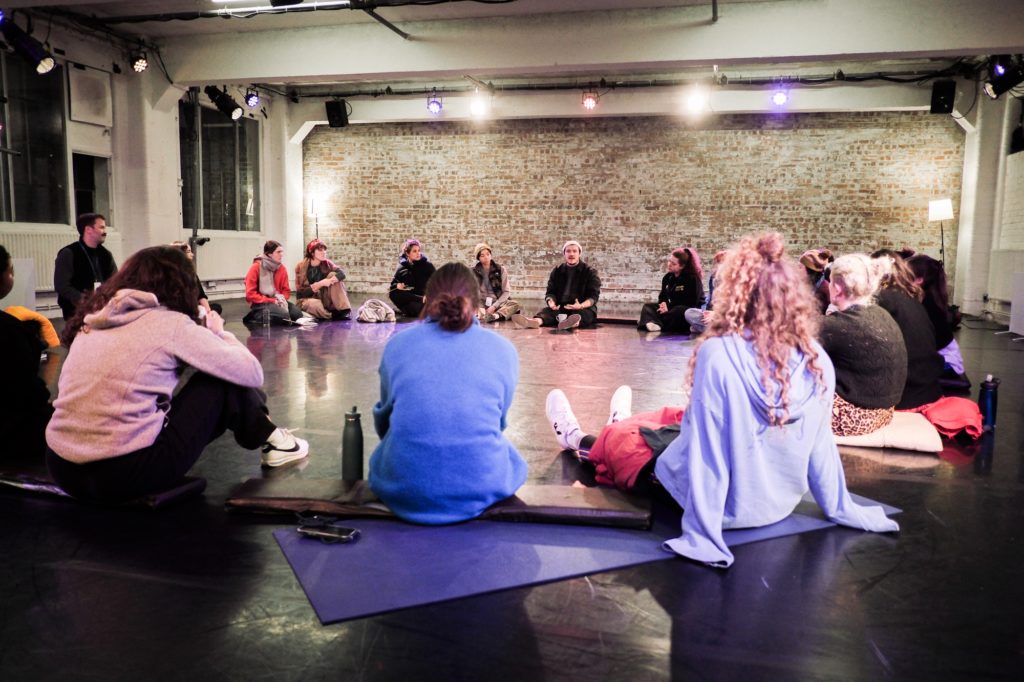Words by Georgia Howlett.
Diagonal Dance’s conference event Stretch returns for a second year, this time without funding, but with plenty more to say. Movement bookmarks a day of conversation and connection, with a morning session led by Rachel Elderkin and an evening performance by Birthday Fish Theatre, who found Fringe festival fame earlier this year. Ironically, many of the topics discussed in between only exist due to a lack of funding. Stretch’s presence is therefore testament to the resilience freelance artists must possess today.
‘Fundraising Today’, a panel with producer Michael Peter Johnson and fundraiser Helen Brooker, did well to prevent despair at what has become a historical low for dance opportunity. It is now common knowledge that to succeed in a funding application, you must work the system and pitch in its language. It can feel tedious and unreflective of our creative work to talk metrics; artists are after all, storytellers. Michael and Helen therefore tackle ways to amplify such abilities, while also ticking boxes of cold, hard data. Though the question of ‘what does your art fix?’ feels arbitrary, it can be reframed as ‘why is your work needed’?, so not to lose its essence, its intrinsic ‘why?’
In a utopia, artists wouldn’t need to prove why their work matters, they would be granted trust (and funds), to create. Funding applications are a technique that ideally are refined with every rejection, but lack of feedback from funders results in a sense of plateau, a lucky gamble with little way to know whether you are actually getting closer. This panel dares us to address this power imbalance and pressure funders for feedback.
Plans for action
– Create a master bid, then filter it for specific funders
– Use targeted research and choose funders that align with your type of work
– Acquire statistics from charities relevant to your project themes
– Demand better practises from funders



The theme of rejection is implicit when discussing the dance scene, but it made frequent, in-depth appearances in another panel, ‘Mental Health and Wellbeing for Dance Professionals’, with Dance Psychologist Dr. Lucie Clements and Finleigh Zack. My enthusiasm for this panel sadly only reflects how little of this kind of discussion exists.
The arts is a paradox in that it can both heal and perpetuate poor mental health. This contradiction makes it difficult to acknowledge that what we love the most, may be the very thing causing us suffering, and hard also to identify when passion becomes obsession. Thus, self-care in the dance industry is sorely needed.
Working with both students and professionals, Lucie is well accustomed to the void of mental health awareness in young dancers. Her clinical experience meshed with Finleigh’s lived experience as a mental health advocate provided countless gems of insight. Most poignantly, the identity crisis that occurs when dance goes from an intrinsic motivation, that flame or passion, to an extrinsic motivation that breeds pressure, competition and perfectionism, not aided by the fact, as pointed out in a later panel, that society pits artists against each other.
Not only does overidentifying as ‘a dancer’ position our identity in an industry, rather than in ourselves, it also prevents us from gaining nourishment from whatever doesn’t fit the bracket of ‘dancer’. How do we maintain the intrinsic motivation for doing what we do, when the reality is, we are dependent on external factors to be successful? We try to redefine successful. The reason we do what we do changes over time. We can also be nourished and inspired from many things beyond dance that are as meaningful, and certainly more forgiving. Reece McMahon, Executive Director of Chisenhale Dance Space (CDS) emphasises the importance of away days, and Lucie reminds us that dance doesn’t have to be our entire personality. In fact, it’s best if it isn’t.
We can also grant ourselves more softness when facing rejection. A sense of collective loneliness pervades, a shared feeling that we are the problem, when in fact, the dance industry is to blame. (There is problem too with describing dance as an industry, as this implies economic gain). Back to our utopia, ideally young dancers should be prepared better for the realities of the ‘industry’, but for this to be worth the time of educators like Lucie, professionals actually need to practise mental health advocacy too. For us artists who lacked solid mental health training as adolescents, community led initiatives such as Chisenhale Dance Space, or Movement Connects in East Anglia, offer safe, kind spaces to counteract that perceived loneliness. Though it feels we are moving as individuals through this career, in fleeting collaborations and transient spaces there is a community, and a big one indeed.
Plans for action
– Open dialogue with peers and colleagues
– Tools such as habit chaining and emotion labelling
– Asking ourselves how an act of mindfulness can actually fuel creativity?
– Remembering that making time for mental health can save time later
– Consider ‘I dance’ rather than ‘I am a dancer’
A relaxed panel loosely guided by Nya Bardouille and Reece of CDS, and Emma Zangs and Steph Townsend of Movement Connects, epitomised the solidarity we all need and desire. Two artist-led initiatives, both vital non-institutional hubs to the communities of artists they serve, shared the ways they make space for artist autonomy. They encourage strategic decision making and proactivity, as the arts can only be described as a very active practise, while at the same time reminding us that there is no definition for being an artist, just being is qualified enough.
As Birthday Fish unfolds, I take consolation in this, and in Stretch as a reminder that despite all we are up against, the artists in all of us cannot, and will not be silenced.




